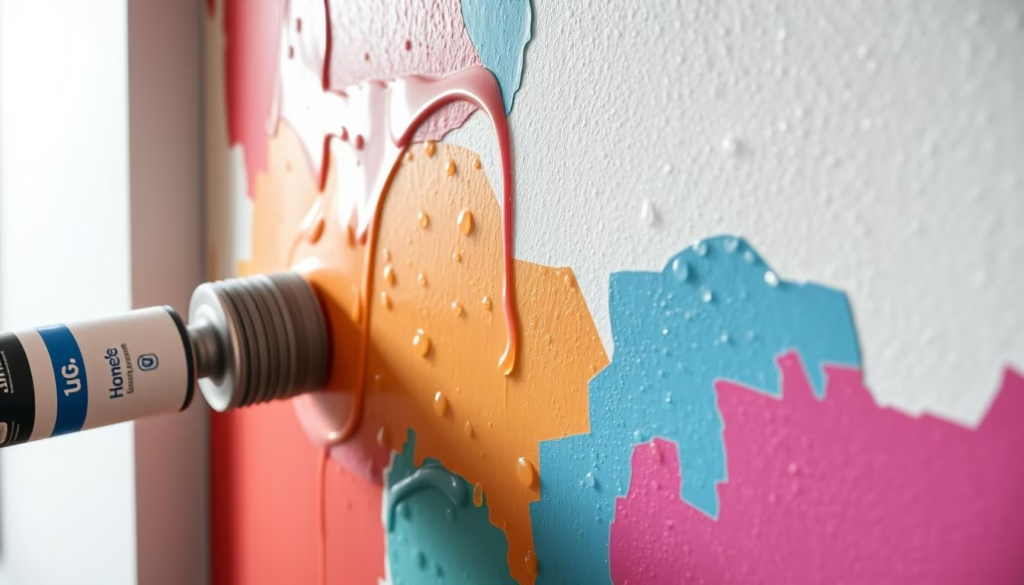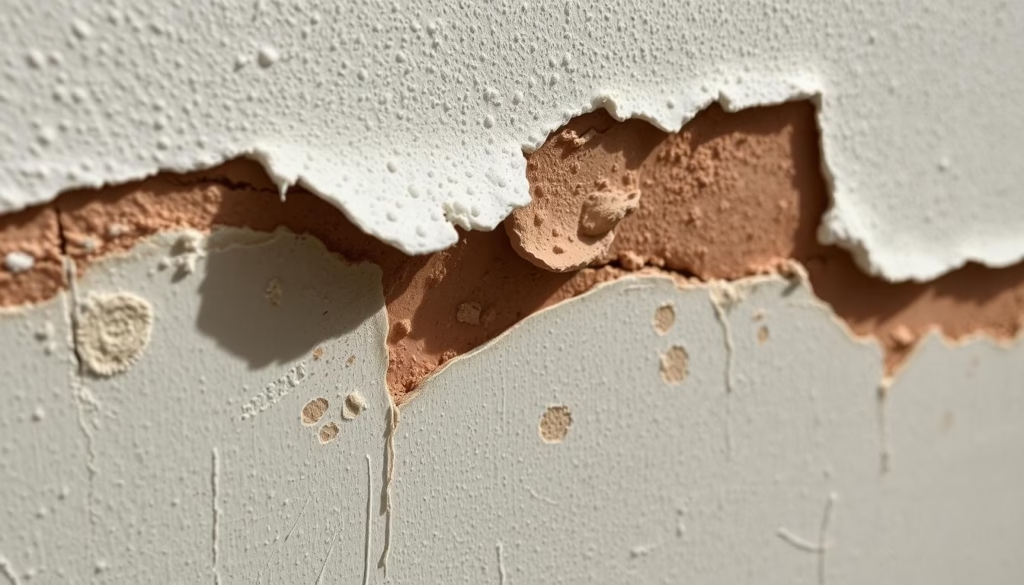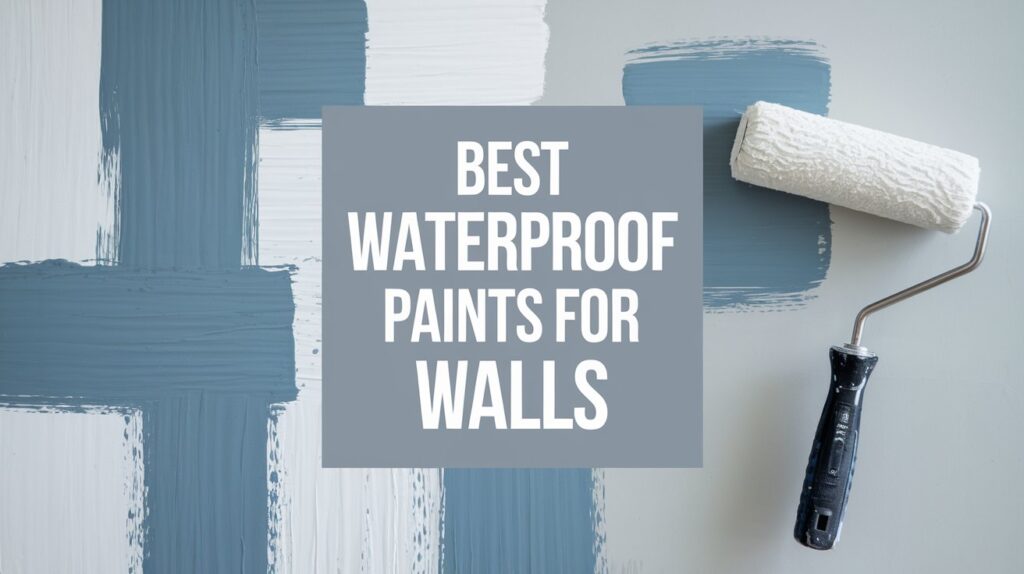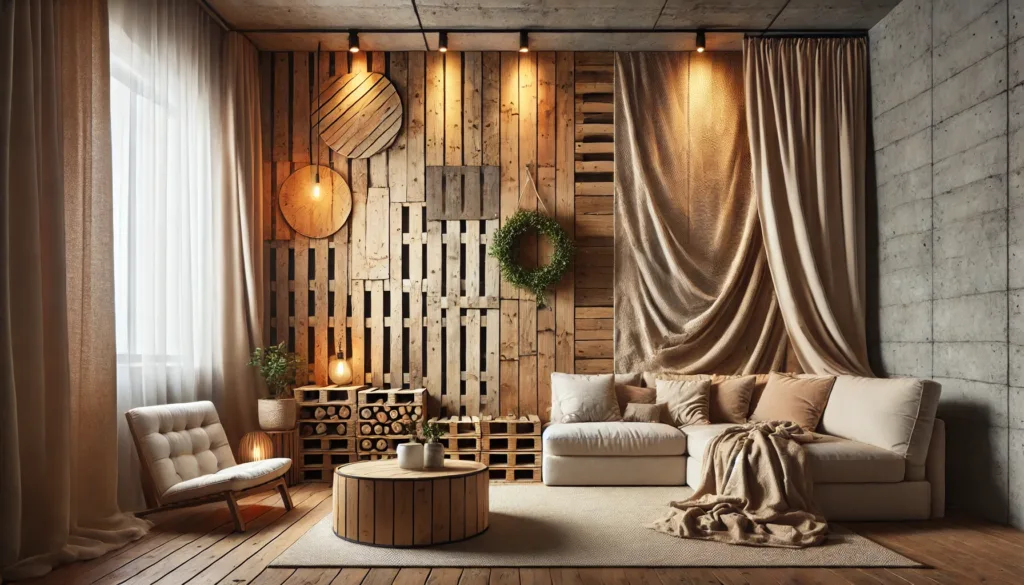Are you tired of fighting moisture and water damage in your home? Waterproof paint is the answer. It protects your home from water damage and makes your walls look better for longer. Let’s dive into why waterproof paint for wall is important, the types available, and what makes it special for your home.

Key Takeaways
- Waterproof paint safeguards your walls from moisture-related issues like mold, mildew, and structural damage.
- Understand the different waterproof paint options for various wall surfaces and their unique benefits.
- Discover the essential features of high-quality waterproof paint, including chemical composition, water resistance ratings, and breathability.
- Learn about the best waterproof paint solutions for both interior and exterior walls, along with proper application techniques.
- Explore the cost considerations and factors to consider when choosing between professional and DIY waterproof paint projects.
Understanding the Importance of Waterproof Paint Protection
Keeping your home’s walls in good shape is key. Waterproof paint helps a lot with this. It protects your walls from moisture problems, water damage, and mold.
Common Moisture Problems in Homes
Moisture in homes comes from leaks, high humidity, and bad ventilation. These can cause mold and damage walls. Waterproof paint stops this by blocking moisture.
Impact of Water Damage on Wall Structures
Water damage hurts walls a lot. It makes drywall swell and crack. This weakens your home’s structure.
It also lets mold grow, which is bad for your health. It makes the air inside your home unhealthy.
Benefits of Preventive Waterproofing
Using waterproof paint stops moisture problems before they start. It keeps water out and protects your walls. This keeps your home looking good and its value high.
“Waterproof paint is an essential tool in the fight against moisture-related problems, ensuring the longevity and structural integrity of your home’s walls.”
Types of Waterproof Paint for Different Wall Surfaces
Choosing the right waterproof paint for wall is crucial. Not all paints are the same. They vary in how well they work and last. Let’s look at the different waterproof colour options for various wall surfaces:
Acrylic-based Waterproof Paints
Acrylic-based paints are great for both inside and outside walls. They are very good at keeping water out. This makes them perfect for places like bathrooms and basements. Plus, they dry smooth and are easy to use.
Epoxy-based Waterproof Paints
Epoxy-based waterproof paint for wall is tough and lasts a long time. It’s best for places that get a lot of water, like pool decks. These paints have a shiny finish and can handle chemicals and scratches well.
Silicone-based Waterproof Paints
Silicone-based waterproof colour paints are top-notch at keeping water away. They’re often used on outside walls to fight off weather and UV rays. They also work well inside, creating a barrier against moisture.
“The right waterproof wall paint can make all the difference in safeguarding your home against the damaging effects of water and moisture.”
Knowing the special features of each paint type helps you pick the best one. This ensures your walls stay protected and look great for a long time.
Essential Properties of Quality Waterproof Paint
Protecting your walls from moisture and water damage is key. The chemical makeup and quality of waterproof paint are crucial. These factors affect the paint’s durability, water resistance, and ability to breathe.
Chemical Composition and Durability
Top-notch waterproof paints mix polymers, resins, and additives. This blend boosts their ability to repel water. It also makes the paint last longer, avoiding cracks, peels, and fading.
Water Resistance Ratings Explained
- Waterproof paints have water resistance ratings that show their protection level.
- These ratings go from low to high. High-performance paints offer better water resistance and protection against moisture.
- Knowing the water resistance rating is key when picking the right paint for your needs, indoors or outdoors.
Breathability and Moisture Control Features
Good waterproof paints let walls breathe and release moisture while keeping them dry. This stops condensation and mold or mildew, making your home healthier.
| Property | Description |
|---|---|
| Waterproof Barrier | Creates a strong barrier against water and moisture, stopping leaks and damage. |
| Durability | Made with polymers and resins for lasting performance, resisting damage. |
| Breathability | Allows walls to breathe and release moisture, preventing condensation and mold/mildew. |
| Moisture Control | Manages moisture flow, keeping your indoor environment healthy. |
Knowing the key properties of waterproof paint helps you choose wisely. This ensures your walls stay protected from water and moisture damage for a long time.
Best Waterproof Paint for Exterior Walls
Protecting your home’s exterior walls from moisture is key. The right waterproof paint is essential. It should block water, last long, and look good.
The local climate is a big factor in choosing paint. In wet or salty areas, you need paint that really keeps water out. Acrylic-based exterior waterproofing paints are good because they handle weather well and let walls breathe.
Also, think about your wall type. Masonry walls like brick or concrete need special paint. So do wooden exteriors. Clean and prime the surface well to help the paint stick and last.
Durability and Moisture Control
The best paint fights mold and mildew. It should also resist cracking, peeling, and fading. Look for paints with special additives and polymers for better moisture and UV protection.
Good paint lets walls breathe by moving water vapor. This stops moisture buildup inside walls, which can cause damage.
Choosing the right waterproof paint for your home’s exterior is important. It keeps your investment safe and your home looking great for years.
Interior Waterproof Paint Applications and Techniques
Protecting your home’s interior walls from moisture damage is key. The right waterproof wall paint application is essential. Learning how to prepare the surface, choose tools, and manage drying times is crucial for lasting protection.
Surface Preparation Methods
Good surface prep is the base for waterproof paint success. Begin by cleaning walls well, removing dirt, grease, and old paint. This ensures the new paint sticks well. You might need to sand, patch, or prime the walls first, depending on their state.
Application Tools and Equipment
Using the right tools makes painting easier. For interior waterproof paint, a high-quality roller or sprayer works best for even coverage. Always work in a well-ventilated area and wear gloves and a respirator for safety.
Drying Time and Curing Process
Waterproof paint needs careful attention to drying and curing times. Always follow the product’s instructions, as drying times vary with temperature and humidity. Don’t rush it to avoid losing the paint’s water-resistant qualities. Let it cure fully as recommended.
By following these best practices for applying interior waterproof paint, you can keep your home’s walls safe from moisture damage. This ensures a beautiful, lasting finish.
Waterproof Paint Cost Analysis and Budget Planning
When planning a waterproof paint project, it’s key to budget wisely. The cost of waterproof paint varies based on several factors. These include the paint type, area size, and application labor.
To plan your budget well, let’s look at the main cost factors for waterproof paint projects:
- Waterproof paint materials: Paint costs range from $30 to $80 per gallon, depending on quality and brand. You’ll need to calculate the total square footage to figure out how much paint you need.
- Surface preparation: Cleaning, patching, and priming are essential for a successful paint job. This step can cost an extra $1 to $3 per square foot.
- Labor costs: Hiring professional painters can cost between $50 to $100 per hour. This depends on the project’s complexity and the painters’ experience.
- Specialized equipment: Some paint jobs require special tools, like spray guns or high-quality brushes. These can increase your expenses.
To make a good budget, consider these tips:
- Measure the area accurately to figure out how much paint you’ll need.
- Look for the best deals by comparing prices from different suppliers or retailers.
- Get quotes from several painters to compare costs and services.
- Include extra money for unexpected costs, like repairs or more surface prep, to avoid going over budget.
- Set aside a contingency fund for any surprises that might come up during the project.
By planning your budget carefully and considering all costs, you can complete your waterproof paint project within your budget. This will protect your home for a long time.
| Cost Item | Range |
|---|---|
| Waterproof paint materials (per gallon) | $30 – $80 |
| Surface preparation (per square foot) | $1 – $3 |
| Labor costs (per hour) | $50 – $100 |

“Careful budget planning is essential for a successful waterproof paint project, ensuring you achieve the desired results without exceeding your financial constraints.”
Professional vs. DIY Waterproof Paint Application
When it comes to waterproofing your walls, you have two main options. You can hire professional contractors or do it yourself. Each option has its own benefits and things to consider. Knowing the differences can help you choose the best option for you.
When to Hire Professionals
For complex waterproofing tasks or big moisture problems, hiring professionals is wise. They have the skills, experience, and tools needed for a good job. They can find the problem, pick the right paint, and apply it correctly for lasting protection.
Required Skills for DIY Projects
If you’re handy at home, you might try DIY waterproofing. It can save money, but you need to prepare well, apply correctly, and stay safe. You’ll need to find the right waterproof paint for wall, follow the instructions, and apply it evenly.
Safety Considerations and Precautions
Whether you hire pros or do it yourself, safety is key with waterproof paints. These paints have strong chemicals and need special gear to use safely. Make sure you have good ventilation, follow safety rules, and dispose of materials properly.
Choosing between hiring pros or doing it yourself depends on the job, your skills, and the risks. By thinking about the pros and cons, you can make a smart choice. This choice will help keep your home’s walls safe and sound for a long time.
Maintaining Waterproof Paint Coatings
Keeping waterproof paint coatings in top shape is crucial. Homeowners who choose waterproof paint need to follow a few easy steps. This will keep their walls looking great and the long-lasting waterproofing benefits intact.
Regular Cleaning and Inspection
Waterproof paint needs regular cleaning to remove dirt and dust. Use a mild detergent and a soft-bristle brush for gentle scrubbing. Be careful not to harm the coating.
After cleaning, check the paint for any wear, peeling, or cracking. Spotting problems early can prevent bigger issues and keep the paint lasting longer.
Addressing Damage Promptly
If you notice minor cracks or chips, fix them quickly. Use a high-quality waterproof paint sealant or patching compound. Follow the instructions carefully to repair the damage.
This will keep the waterproof coating strong and stop water from getting in.
Reapplying as Needed
Waterproof paint may need to be reapplied every few years. Watch for signs of wear and be ready to recoat when needed. Using the right techniques is key for a smooth, lasting finish.
| Maintenance Task | Frequency | Benefits |
|---|---|---|
| Cleaning | Quarterly | Removes dirt and debris, preserves appearance |
| Inspection | Bi-annually | Identifies potential issues before they worsen |
| Repair | As needed | Maintains the integrity of the waterproof coating |
| Reapplication | Every 5-7 years | Renews the waterproof protection for long-term use |
By sticking to these waterproof paint maintenance tips, homeowners can keep their long-lasting waterproofing effective. This will protect against moisture and water damage for many years.
Troubleshooting Common Waterproof Paint Issues
Waterproof paint is great for keeping walls safe from moisture damage. But, even the best paint can face problems over time. Knowing how to spot and fix common issues is essential for keeping your walls in good shape.
Peeling and Bubbling Solutions
Peeling or bubbling can happen for many reasons. It might be because the surface wasn’t prepared well, there’s too much moisture, or the paint doesn’t match the wall. To fix this, clean and prime the area well before painting again. Sometimes, you need to remove the old paint to get a good bond.
Addressing Color Fading
Even waterproof paints can fade from sunlight and UV rays. Look for paints with UV blockers or apply a clear sealant. Regular cleaning and touch-ups can also keep the color bright.
Repair Techniques for Damaged Areas
- For small damage, use a putty knife to fill cracks or holes with waterproof sealant or compound.
- For bigger damage, sand the area, apply primer, and repaint to get a smooth finish.
- In severe cases, remove the damaged paint and start over for a fresh coat.
It’s important to watch for waterproof paint problems and fix them quickly. By knowing the common issues and how to solve them, you can keep your walls safe and looking good.

Environmental Considerations and VOC Content
When picking a waterproof paint for your walls, think about the environment. Many old waterproofing products have harmful VOCs. But, now there are eco-friendly paints that are good for the planet and work well.
More people are choosing low-VOC paints. These paints have fewer VOCs, which means less bad stuff in the air. Choosing eco-friendly paint helps keep your home healthy and protects your walls from water damage.
Advantages of Eco-Friendly Waterproof Paint
- Less harm to the environment and lower carbon emissions
- Better air inside and health for everyone living there
- Meets strict green rules and building standards
- Keeps moisture and water away for a long time
| Feature | Eco-Friendly Waterproof Paint | Traditional Waterproof Paint |
|---|---|---|
| VOC Content | Low to No VOCs | High VOCs |
| Environmental Impact | Minimal, sustainable | Significant, contributes to pollution |
| Health Considerations | Healthier indoor air quality | Potential health risks |
| Moisture Protection | Excellent, long-lasting | Excellent, long-lasting |
Choosing eco-friendly waterproof paint and low VOC waterproofing means better protection from moisture. It also means less harm to the environment. These new products show the latest in waterproofing, giving homeowners a green choice.
Latest Innovations in Waterproof Paint Technology
The world of waterproof paint is always changing. Homeowners are seeing big benefits. New formulas and ways to apply paint are making a big difference.
Nanotechnology is making waterproof paints even better. These paints use tiny particles to block moisture. They last a long time and still look great, even in tough weather.
Now, there are paints that clean themselves. They push dirt and algae away. This means your home looks better and you don’t have to clean it as often.
Applying paint has also gotten easier. Spray-on systems make covering walls simple. They work well in tricky spots, giving a smooth, moisture-proof finish.
The need for innovative waterproof paint and advanced waterproofing solutions is rising. The future looks bright with new, green paints and self-fixing coatings. Homeowners will have even more ways to keep their homes safe from water damage.
Conclusion
Waterproof paint offers great moisture protection for your home. It keeps your walls safe from water damage. Knowing the different types of waterproof paint helps homeowners choose the right one for their needs.
Looking to protect your home’s exterior or interior? The right waterproof paint is key. It keeps your home looking good and strong. High-quality paint means your home is safe from water damage.
When waterproofing your home, think about new paint technologies and their impact on the environment. Also, consider the cost. With the right choice, you can make your home healthier and more durable. Enjoy your home for many years to come.
FAQ
What is waterproof paint and how does it differ from regular paint?
Waterproof paint is a special coating that stops moisture and water. It’s made differently than regular paint. It has compounds that keep water out of the surface.
What are the benefits of using waterproof paint for walls?
Waterproof paint protects walls from moisture damage and mold. It keeps walls strong and looks good for longer.
What types of waterproof paint are available for different wall surfaces?
There are many types of waterproof paint. Acrylic paints work well inside, epoxy for wet areas, and silicone for outside walls.
How do I know if a waterproof paint is of good quality?
Good waterproof paint resists water well and lasts long. It should also let surfaces breathe and control moisture. Look for low VOC content for the environment.
What is the best waterproof paint for exterior walls?
The best paint for outside walls depends on the weather and wall type. Look for silicone, elastomeric, or acrylic paints with high water resistance.
How do I properly prepare the wall surface before applying waterproof paint?
Clean and prime the wall before painting. This ensures the paint sticks well and works right.
How much does waterproof paint cost, and how can I budget for a waterproofing project?
Waterproof paint costs more than regular paint. But it saves money by avoiding water damage. Plan your budget carefully, including material and labor costs.
When should I hire a professional for a waterproof paint application, and what are the benefits?
Get a pro for big or tricky projects. They know how to do it right and make it last.
How do I maintain and care for waterproof paint coatings?
Clean and check the paint often. Fix any damage quickly. Follow the maker’s cleaning and re-coating tips to keep it lasting.
What are the latest innovations in waterproof paint technology?
New waterproof paint is eco-friendly and self-cleaning. It’s also more durable and lets surfaces breathe better.

